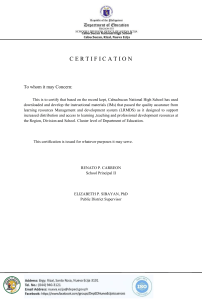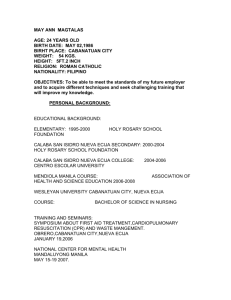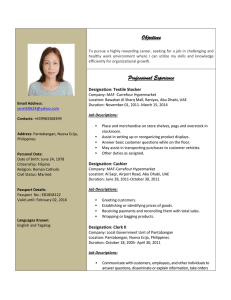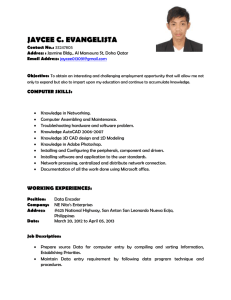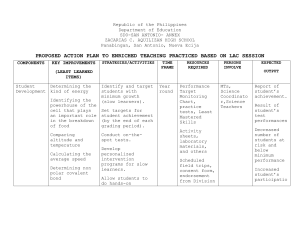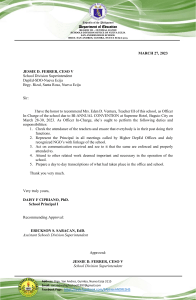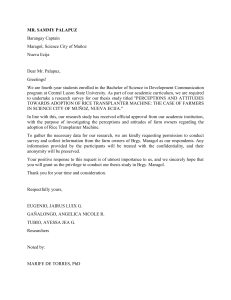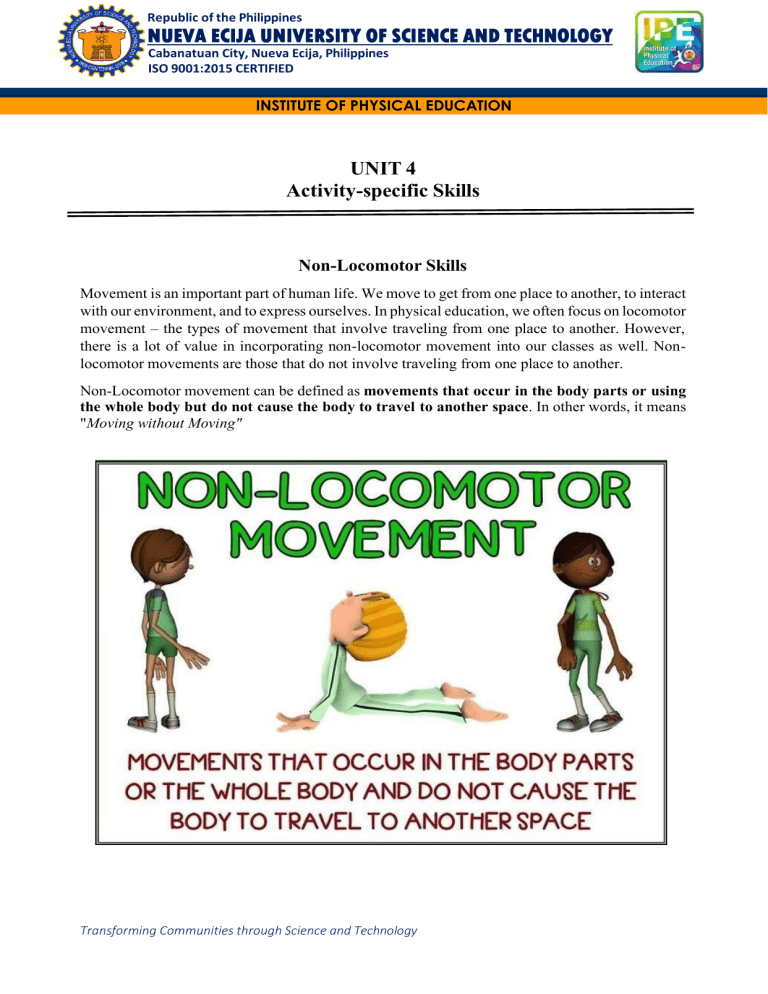
Republic of the Philippines NUEVA ECIJA UNIVERSITY OF SCIENCE AND TECHNOLOGY Cabanatuan City, Nueva Ecija, Philippines ISO 9001:2015 CERTIFIED INSTITUTE OF PHYSICAL EDUCATION UNIT 4 Activity-specific Skills Non-Locomotor Skills Movement is an important part of human life. We move to get from one place to another, to interact with our environment, and to express ourselves. In physical education, we often focus on locomotor movement – the types of movement that involve traveling from one place to another. However, there is a lot of value in incorporating non-locomotor movement into our classes as well. Nonlocomotor movements are those that do not involve traveling from one place to another. Non-Locomotor movement can be defined as movements that occur in the body parts or using the whole body but do not cause the body to travel to another space. In other words, it means "Moving without Moving" Transforming Communities through Science and Technology Republic of the Philippines NUEVA ECIJA UNIVERSITY OF SCIENCE AND TECHNOLOGY Cabanatuan City, Nueva Ecija, Philippines ISO 9001:2015 CERTIFIED INSTITUTE OF PHYSICAL EDUCATION Benefits of non-locomotor movement There are many benefits to incorporating non-locomotor movement into physical education. One benefit is that it helps students develop body awareness and control. Non-locomotor movements require students to use different parts of their bodies and to be aware of how their bodies are moving through space. This also helps them improve their focus and concentration. When students are focused on the movement they are doing, they are less likely to be distracted by other things going on around them. Another benefit of non-locomotor movement is that it can help improve students' balance and coordination. Balance and coordination are important skills for students to have to participate in physical activity safely and effectively. Non-locomotor movements can help students develop these skills by challenging them to maintain their balance while moving their bodies in different ways. Finally, non-locomotor movement can help students develop strength and flexibility. Many nonlocomotor movements require students to use their muscles in new ways, which can help them build strength. And, because many non-locomotor movements involve stretching or reaching, they can also help students increase their flexibility. Non-Locomotor Movements Balance: An even distribution of weight enabling you to remain upright and steady. Bend: To move from a straight position into a curved position at a joint. Curl: To form your body into a curved. Pull: Executing force to cause objects/people to move toward one's body. Push: Applying force against an object or person to move it away from one's body or to move one's body away from the object or person. Stretch: Causing a specific muscle to become longer than its normal resting length. Sway: Shifting weight from one side to the other side in a smooth fashion. Swing: Moving a body part side to side or forward and back like a pendulum. Turn: Rotating the body along the long axis. Twist: The rotation of a body part around its axis. Many of the movement skills listed above are utilized in a variety of physical education activities, games, and sports. They are often combined with other fundamental body movements such as locomotor movement and manipulative skills. Defining the terms, along with demonstrating and Transforming Communities through Science and Technology Republic of the Philippines NUEVA ECIJA UNIVERSITY OF SCIENCE AND TECHNOLOGY Cabanatuan City, Nueva Ecija, Philippines ISO 9001:2015 CERTIFIED INSTITUTE OF PHYSICAL EDUCATION practicing the skills will allow our students to learn the different movement concepts and help them acquire the skills necessary for increasing their overall physical literacy. One way of incorporating non-locomotor movement is to use it as a warm-up activity. Nonlocomotor movements can help students loosen up their muscles and prepare their bodies for the activities to come. You can also use non-locomotor movements to teach specific skills or concepts. For example, if you are teaching students to swing a bat from a tee, they can first perform the motion without the bat, using only their body. Additionally, non-locomotor movements can be used as a cool-down activity. This can help students wind down after strenuous activity and prepare their bodies for rest. Non-locomotor movements can help students develop body awareness and control, balance and coordination, and strength and flexibility. All of these are important skills for students to have to participate in physical activity safely and effectively. Transforming Communities through Science and Technology Republic of the Philippines NUEVA ECIJA UNIVERSITY OF SCIENCE AND TECHNOLOGY Cabanatuan City, Nueva Ecija, Philippines ISO 9001:2015 CERTIFIED INSTITUTE OF PHYSICAL EDUCATION Locomotor Skills The locomotor skills are the basic technique to move from one place to another. It is the foundation of coordination that allows routines and games to be created. The feet are used for support in locomotor movements. However, the body can also travel on other components such as the hands and feet. The aim of using these skills is to keep the body dynamically stable while it is being moved. All skills develop through a series of stages: basic, or learning the fundamental techniques; intermediate, or gradually shifting to a more concentrated effort to hone the skills; proficient, or when the movement becomes automatic or effortless and efficient; and advanced, or the capacity to use the skills in a variety of contexts and situations with escalating levels of quality. The locomotor skills such as walking, running, skipping, and hopping are learned during our early age, but the question is does these locomotor movements executed properly? The muscles most involved in locomotor skills are quadriceps (front of the thighs), hamstrings (back of the thighs), buttocks muscles, the stomach muscles, calf muscles and the secondary muscle such as hips, shin, foot and also the arm and the shoulder. These parts work together to allow your body to move. It is important to execute the different locomotor skills properly that will be useful for dancing, physical activity and exercise, and in performing different sports. Developing and maintaining lifetime physical activity habits requires mastery of fundamental motions such as locomotor abilities. The locomotor skills such as crawl, creep, jump and land, skip, and run movements can be execute thru linear and lateral movements. ▪ Creeping - moving on all four limbs with the body distant from the ground. ▪ Crawling- done on all four limbs, moving forward by dragging the body close to the ground. ▪ Hopping- done by propelling the body off ground using one leg and landing on the foot of the same leg. ▪ Jumping – occurs when the body is projected into the air by force generated in one or both legs and the body lands on one foot or both feet. (Phases of jumping: 1- take off; 2- flight; 3- landing) ▪ Landing – the last phase in jumping. ▪ Lateral Movement – denotes extension or movement to the side, while contralateral refers to the other side and is used to describe opposite sides of the body working together. ▪ Leaping – is widely springing from one place to another by pushing off the ground on one foot and landing using the other foot. ▪ Linear Movement- is one type of motion wherein movement occurs in a straight path. ▪ Locomotor Skills- involve transporting the body or traveling from one point to another with the goal of maintaining dynamic stability while the body is displaced. ▪ Motion – defined as an individual change in space over a time period. ▪ Running – occurs when the legs alternate to propel the body through the air or the support phase; both feet are lifted off the ground or the flight phase, and a foot strikes the ground upon landing or the recovery phase. ▪ Skipping – consist of a forward step followed by a hop on the same foot. There is alternation of the lead leg with an uneven rhythmic pattern. The Crawling and Creeping Exercises Crawling exercise are multi-joint movements that work the entire body while focusing on the core and shoulder muscles. Basic crawling patterns help you develop upper and lower body Transforming Communities through Science and Technology Republic of the Philippines NUEVA ECIJA UNIVERSITY OF SCIENCE AND TECHNOLOGY Cabanatuan City, Nueva Ecija, Philippines ISO 9001:2015 CERTIFIED INSTITUTE OF PHYSICAL EDUCATION coordination, which is crucial for almost any physical activity you engage in. It is serves as the foundation for our walking pattern, which is likely the most “functional” exercise we perform on a regular basis. It can also help you identify difficulties with your walking pattern and over time, improve your walking efficiency. Let’s start with the most basic pattern that will maintain the spinal stability while moving the limbs in lateral or in contra-lateral. Crawling on your hands, knees, and feet is often referred to as creeping. You want to start with creeping because it provides a larger base of support, and you perform it in a slower manner. Simple creeping works wonders for the hips, shoulders, and core. Humans are built to go in opposite directions. This implies you should walk with left arm in front of your right leg and your right arm in front of your left leg. Crawling can assist in resetting these normal contralateral tendencies, lowering your chance of injury. Creeping is the term for crawling on your hands, knees and feet. You should begin with crawling since it gives a bigger foundation of support and allows you to move more slowly. The hips, shoulders and core all benefit with simple crawling. This is the most crawling pattern. To begin crawling, get down on your hands and knees and position your arms squarely under your shoulders and your knees precisely under your hips. Your toes should be tucked and your feet should be grounded instead than pointing. At all times, maintain a flat back. To crawl forward, backward, or sideways, refer to the diagram and then follow these steps. Sample Crawling Exercises Standard Progression Linear bear crawl Linear Movement Baby Crawl Linear crab crawl Gorilla crawl Plank walk Lateral bear crawl Lateral Movement Circular Crawl Lateral crab crawl Lateral gorilla crawl Lateral side walk Transforming Communities through Science and Technology Republic of the Philippines NUEVA ECIJA UNIVERSITY OF SCIENCE AND TECHNOLOGY Cabanatuan City, Nueva Ecija, Philippines ISO 9001:2015 CERTIFIED INSTITUTE OF PHYSICAL EDUCATION Baby Crawl Starting Position: • In a quadruped position, align the knees under the hips and the wrist under the shoulders. Procedure: • Move contralaterally by stepping forward with one hand and opposite knee. • Repeat with the other hand and knee. • Keep the steps small so that the opposite arm and leg can work together. • Crawl backwards by performing the same contralateral movement pattern. Circular Crawl The circular crawl involves circling a location below your belly button with your hands and feet. Note: Do not circle your body around your hands. Starting Position: • Same as the baby crawl. Procedure: • Pretend there is a string attached under the belly button to the ground. • Start to circle, stepping with the opposite hand and foot. • Circle around the belly and not around the hands. Note: Take small steps. Neck in neutral position. Core is engaged throughout the movement. a c b d Exercise Progression Transforming Communities through Science and Technology Republic of the Philippines NUEVA ECIJA UNIVERSITY OF SCIENCE AND TECHNOLOGY Cabanatuan City, Nueva Ecija, Philippines ISO 9001:2015 CERTIFIED INSTITUTE OF PHYSICAL EDUCATION Bear Crawl After you’ve mastered creeping, try doing bear crawls with just your hands and feet. Get down on your hands and knees and position your hands squarely under your shoulders and your knees precisely under your hips to prepare for crawling. Then, if it seems more comfortable raise your knees off the ground and turn your hands and feet slightly outward. Your knees should be bent and your buttocks should be low. Then, to go forward, backward and lateral movement, follow these steps: 1. Linear Bear Crawl Starting Position: • Same as the baby crawlbur slightly lift the knees about two (2) inches off the ground. Procedure: • • • Move contralaterally by walking forward with one foot and the opposite hand. Keep crawling forward, moving the opposite arm and opposite leg together. Crawl backwards by keeping the same movement pattern. Transforming Communities through Science and Technology Republic of the Philippines NUEVA ECIJA UNIVERSITY OF SCIENCE AND TECHNOLOGY Cabanatuan City, Nueva Ecija, Philippines ISO 9001:2015 CERTIFIED INSTITUTE OF PHYSICAL EDUCATION 2. Lateral Bear Crawl Starting Position: • Same as the linear bear crawl. Procedure: • Move sideways to your left by walking the lefthand and right knee similtaneously to the right a few inches. • Follow with the right hand and left knee moving in the same direction. • Continue crawling over s et of distance. • Reverse the pattern by moving to your right, walking with the right hand and left knee simultaneously. • Follow with the left hand and right knee. • Continue crawling over a set of distance. Note: Take small steps to keep the hip stable and to keep up with the contralateral movement. Keep the knees as close as possible to the floor. Do not allow hips to rise. Keep the lower back from rounding. Maintain the brace. Transforming Communities through Science and Technology Republic of the Philippines NUEVA ECIJA UNIVERSITY OF SCIENCE AND TECHNOLOGY Cabanatuan City, Nueva Ecija, Philippines ISO 9001:2015 CERTIFIED INSTITUTE OF PHYSICAL EDUCATION Crab Crawl The crab crawl is a fun and novel method to move around, but because it is a version of crawling, it can be tougher on the shoulders and rotator cuff muscles. 1. Linear Crab Crawl Starting Position: • Sit on the floor with knees bent and feet flat. • Place hands on the flor behind the glutes and slightly lift the glutes. Procedure: • Move the right hand behind your hip while similtaneously pushing off with the left foot. You are now moving forward with your rear leading. • Follow with the left hand and the right foot. • Continue moving forward over a set distance or number of repetitions. • As a progression, reverse the pattern by crawling back with the feet leading instead of the rear. Transforming Communities through Science and Technology Republic of the Philippines NUEVA ECIJA UNIVERSITY OF SCIENCE AND TECHNOLOGY Cabanatuan City, Nueva Ecija, Philippines ISO 9001:2015 CERTIFIED INSTITUTE OF PHYSICAL EDUCATION 2. Lateral Crab Crawl Starting Position: • Same as the linear crab crawl. Procedure: • Raise the hips off the floor and begin to move sideways. • Step to the right with the right hand and left foot followed by the left hand and right foot. • Continue moving sideways. • Reverse the pattern by stepping to the left with the left hand and right foot, followed by the right hand and left foot. Note: Maintain the abdominal brace throughout the movement. Take small steps to keep up with the contralateral movement. Keep the glutes off the ground. Gorilla Crawl The Gorilla crawl is a great crawl variation to train your legs and core. This is more difficult for many because it requires mobility in the hips. 1. Linear Gorilla Crawl Starting Position: • Start in a crouching position. • Place the weight on the balls of the feet. • Bend over and place the hands on the floor. Procedure: • Shift the weight of the body to the hands as you jump forward. • Land with the feet positioned outside the hands. Transforming Communities through Science and Technology Republic of the Philippines NUEVA ECIJA UNIVERSITY OF SCIENCE AND TECHNOLOGY Cabanatuan City, Nueva Ecija, Philippines ISO 9001:2015 CERTIFIED INSTITUTE OF PHYSICAL EDUCATION • • Reach forward again and place the hands on the floor before jumping. Continue moving forward over a set distance or a prescribed number of repetitions. 2. Lateral Gorilla Crawl The Lateral Gorilla Crawl requires less hip mobility, but can sometimes be difficult in terms of coordination as you shift your weight from your arms to your feet back to your arms as you move sideways. Starting Position: • Same as gorilla crawl. Procedure: • • • • Lift the hands and reach out to the left. Place the hands on the floor and jump with the feet past the hands to the left. Continue moving in the same direction. Reverse the direction but continue to perform the same movement pattern. Note: Stay low in a crouching position throughout the entire movement. Reach out with the hands as soon as as the feet land on the floor. Transforming Communities through Science and Technology Republic of the Philippines NUEVA ECIJA UNIVERSITY OF SCIENCE AND TECHNOLOGY Cabanatuan City, Nueva Ecija, Philippines ISO 9001:2015 CERTIFIED INSTITUTE OF PHYSICAL EDUCATION Plank Walk The Plank Walk is a harder crawl variation for the core and shoulders. You’re basically holding a plank while crawling back and forth, which really works your abs. 1. Linear Plank Walk Starting Position: • Start on a straight-arm plank position. • Keep the wrist under the shoulders. • Extend the legs and keep the feet close together. Procedure: • Take a small step forward with the right hand and left foot followed with left hand and right leg. • Continue moving in the same direction. • Keep the steps small. • Maintain the plank by keeping the body in a straight line and knee straight. • Reverse the direction. 2. Lateral Plank Walk The Lateral Plank Walk is another lateral crawl that is great way to challenge your core and shoulders. Transforming Communities through Science and Technology Republic of the Philippines NUEVA ECIJA UNIVERSITY OF SCIENCE AND TECHNOLOGY Cabanatuan City, Nueva Ecija, Philippines ISO 9001:2015 CERTIFIED INSTITUTE OF PHYSICAL EDUCATION Starting Position: • Same as plank walk. Procedure: • • • • Move the right hand close to the left hand as the left foot steps out so the feet are about hip width apart. Then move the left hand out so that hands are about shoulder-width apart as the right foot steps in. Keep moving in one direction bringing the feet together as the hands step out wide and the feet out wide as the hands are back together. Reverse the crawl by moving in the opposite direction. Note: Keep the body in a straight line from the head to the heels. Take small steps at a time to keep the core tight and to lessen the movement on the hip. Neither let the hip sag nor rise up. Keep the hands under the shoulder to avoid strain on the shoulders. Transforming Communities through Science and Technology Republic of the Philippines NUEVA ECIJA UNIVERSITY OF SCIENCE AND TECHNOLOGY Cabanatuan City, Nueva Ecija, Philippines ISO 9001:2015 CERTIFIED INSTITUTE OF PHYSICAL EDUCATION The Standing Series The standing series exercises are locomotor movements done in a standing position such as running, skipping, hopping, jumping and landing. These standing series exercises is very vital in any physical activities. Jumping and Landing Jumping is a fundamental skills of launching oneself, producing lift enough to sustain an amount of time airborne. Jumping skill has major phases: take-off; flight and landing. The main purpose of practicing jumping and landing techniques is to improve knee control and timing. When jumping and landing, the knees should move directly over the feet. Hold this position as you come down and stand for a few seconds with your knees slightly bent. To safely practice proper jumping and landing mechanics, perform simple box jumps and single leg side jumps where the landing is held for three seconds before jumping to the opposite side and landing on the opposite leg. Before doing the drills though, warm first and include exercises that activates glutes like hip flexor and psoas stretch, hip bridge, quadruped hip extension, side lying hip extension. Here are some importanf tips when practicing the jumping and landing skills: First, stand on the edge of a bench or stack of mats piled at knee height squarely. Second, the skills involves a dowward motion of dropping off, then third landing safely. Landing properly is important to minimize risk against injuries and to also put you in a position where you will be able to generate force rapidly in order to jump again. 1. Reverse Drop Starting Position: • Stand on the edge of the box or mats. Procedure: • Drive the arms forward as you drop off the box. • Sit back on your hips upon landing to absorb more force and keep the knees from going past the toes. Transforming Communities through Science and Technology Republic of the Philippines NUEVA ECIJA UNIVERSITY OF SCIENCE AND TECHNOLOGY Cabanatuan City, Nueva Ecija, Philippines ISO 9001:2015 CERTIFIED INSTITUTE OF PHYSICAL EDUCATION 2. Jumping (upward motion) and Landing (downward motion) Procedure: • • • • • • • • Stand tall and your feet hip width apart. Flex the elbows 90 degrees and hold the arms in front of the chest. Sit back on your hips (half squat) as you extend the elbows behind. Keep your arms along the side of the trunk. Drive the arms forward to activate the legs into jumping forward and landing on the box. Land softly and decellerate the body by disturbing your weight evenly over the entire foot. Keep the spine neutral by looking forward. Keep the knees behind the toes by activating your glutes. Keep the jnees on track or aligned with your toes (i.e.., avoid collapsing the knees inward or nedially). Keep the elbows flexed at 90 degrees and hands above them. Transforming Communities through Science and Technology Republic of the Philippines NUEVA ECIJA UNIVERSITY OF SCIENCE AND TECHNOLOGY Cabanatuan City, Nueva Ecija, Philippines ISO 9001:2015 CERTIFIED INSTITUTE OF PHYSICAL EDUCATION Running In sports, it is described as a gait in which all four (4) feet are off the ground at the same moment. It is a combination of anaerobic and aerobic exercise. Running is a complicated, coordinated action that requires the participation of the entire body. Leaning forward puts the runner’s center of mass on the front half of the foot, avoiding landing on the heel and allowing the spring mechanism of the foot to work effectively. It also makes it simpler for the runner to avoid planting his or her foot in front of the center of gravity, which causes braking. Running is a fantastic way to remain in shape while still having a good time; in fact, virtually become fashionable. It’s crucial, though, to do it correctly. Running is a great way to reach your fitness objectives, whether you’re aiming to reduce weight, enhance your heart health, or simply improve your mood. The best aspect is that nearly anybody can do it; all you need is a pair of running shoes and the desire to get out on the road. To practice the proper arm action, sit with with your legs extended. Sit tall. Observed the proper position of the elbows, hand and shoulder. Move from the shoulder as you swing your arms rhythmically. To practice the leg action, lean against a wall so that the torso is slightly ahead of the hips. Raise one knee while staying on the ball of the support foot. Do knee raises while quickly tapping the raised foot on the ground. Repeat on the same leg thrice before shifting to the other side. Here are important tips when practicing this skill; Arm action Starting Position: • In a sitting position, sit tall (or elongate the spine). • Flex the elbows at a 90-degree angle. • Tuck the elbows close to the trunk. • Keep the shoulders square. Imagine an invisible midline running down the body. • As you swing the arms forward, keep the thumbs to the ceiling in order to avoid crossing the midline. Procedure: • Swing the arms forward and back so that the hands move from chin to hip. Transforming Communities through Science and Technology Republic of the Philippines NUEVA ECIJA UNIVERSITY OF SCIENCE AND TECHNOLOGY Cabanatuan City, Nueva Ecija, Philippines ISO 9001:2015 CERTIFIED INSTITUTE OF PHYSICAL EDUCATION • • • Hold the hands loosely at the wrist joint (as if holding a potato chip with the thumb and index finger). Open up shoulders by pulling them back (i.e..avoid hunching) and squeezing the shoulder blades together. Although it is common to feel tension in your shoulders as you run and become fatigued, you can shake out your arms and repeatedly shrug your shoulders to loosen them up. Fix your gaze in front of you, Neither tilt your chin upp nor down, which tends to occur when fatigued sets in. Leg action Procedure: • Instead of running upright, slightly lean from the hip so that the trunk is slightly forward. • Keep the knee directly in front of the hips by lifting them higher. • As the foot strikes the ground, keep the shin as closely perpendicular to the ground as possible. • Striking the ground with the ball of the foot first can help with forward propulsion. But if you naturally run with a heel strike first, you can focus on getting s psir of shoes with good cushioning instead of changing your stride. Transforming Communities through Science and Technology Republic of the Philippines NUEVA ECIJA UNIVERSITY OF SCIENCE AND TECHNOLOGY Cabanatuan City, Nueva Ecija, Philippines ISO 9001:2015 CERTIFIED INSTITUTE OF PHYSICAL EDUCATION How to run properly? It’s all about form when it comes to running. Running with proper form allows you to run faster and more effectively while lowering your risk of injury. Otherwise, particular muscles or joints, such as your knees or shins, absorb the brunt of the impact, which can lead long-term problems such as stress fractures and tendonitis. Running is obvious for the most part, but there are a few essential points to remember when it comes to maintaining good form: Additionally, keep an eye on your stride. If your foot touches the ground before your knee, your stride is excessively lengthy. Instead, when your foot hits the ground, your knees should be slightly bent and in line the center of your foot. This will aid in the absorption of impact stress in your joints. Breathing properly is another crucial component of running properly. It makes no difference whether you breathe through your nose or mouth as long as your diaphragm (a big muscle positioned below the lungs) is used. Inhale deeply into your belly button without lifting your shoulders to breathe diaphragmatically. This will employ your whole lungs capacity, maintaining a constant supply of oxygen to your muscles. Transforming Communities through Science and Technology Republic of the Philippines NUEVA ECIJA UNIVERSITY OF SCIENCE AND TECHNOLOGY Cabanatuan City, Nueva Ecija, Philippines ISO 9001:2015 CERTIFIED INSTITUTE OF PHYSICAL EDUCATION Sample Sequence of Locomotor Drills for Running Standard High knee march-walk Linear Movement Lateral Movement A-skips-same knee; one side at a time Skips Back pedal Side shuffle Lateral A skips( slow) Lateral high knees Carioca Transforming Communities through Science and Technology Progression High knees jog in place and/or moving A-skips with alternating knee Skip for height Skip for distance Power skipd Lateral A skips( fast) High knee carioca Republic of the Philippines NUEVA ECIJA UNIVERSITY OF SCIENCE AND TECHNOLOGY Cabanatuan City, Nueva Ecija, Philippines ISO 9001:2015 CERTIFIED INSTITUTE OF PHYSICAL EDUCATION Transforming Communities through Science and Technology
